This article was co-authored by wikiHow Staff. Our trained team of editors and researchers validate articles for accuracy and comprehensiveness. wikiHow's Content Management Team carefully monitors the work from our editorial staff to ensure that each article is backed by trusted research and meets our high quality standards.
There are 10 references cited in this article, which can be found at the bottom of the page.
This article has been viewed 23,483 times.
Learn more...
If you work in a medical office, or you’re starting your own practice, scheduling patient appointments is one of your most important tasks. Keeping your appointment schedule well-organized will ensure that no patients get “lost” in the system and that both the patients and physicians have a pleasant experience in the office. Meanwhile, maximizing productivity in your schedule will allow you to book more appointments and increase your office’s revenue.
Steps
Setting Up an Appointment-Scheduling System
-
1Let patients book appointments over the phone, in person, and online. This way, you’ll make sure you’re getting the most patients possible and not losing any potential patients who can't make appointments in one particular way. Enabling people to make appointments online also allows you to take advantage of 24/7 online access and let patients book appointments after hours.[1]
- In addition to this added efficiency, patients also generally report feeling more comfortable and less burdened by online self-scheduling than by making appointments over the phone.
- There is a wide variety online appointment scheduling software you can purchase to use in your office. Some of the most popular software includes AppointmentPlus, Booker, and Thryv. Of course, you can also build your own scheduling software if you have coding and development skills!
-
2Offer patients multiple time-slot options for their appointment. You’ll want to make sure you give your patients as many options as possible so they can choose the best time-slot for their particular schedule. This may seem obvious, but it’s very important for keeping your patients happy and reducing the chance of their having to cancel the appointment because of a time conflict.[2]
- For example, instead of asking a patient if Tuesday at 1:00 works for them, give them the opportunity to select any available time slot that works for them, such as Tuesday from 1:00-2:00, 2:00-3:00, or 4:00-5:00.
Advertisement -
3Take down each scheduled patient's contact information. You’ll need to be able to contact them to remind them of an upcoming appointment or reschedule their next booking. Make sure you ask for the person’s phone number, email address, and mailing address when they first book their appointment.[3]
- If the person makes the appointment in person or over the phone, simply ask them for this information. If they make their appointment online, be sure to include an area in your online portal for patient contact information.
-
4Send patients reminders the day before their appointment. If patients forget their appointment time and don't show up, this leads to a huge block of wasted time in your schedule. Using reminders reduces the risk of patients failing to show up for their appointments and thus helps prevent this waste of time.[4]
- Calling or texting patients is the best type of reminder, since they’re more likely to notice an incoming call or text than they are to see a new email in a short amount of time.
- Using a reminder system may also increase the cancellation and rescheduling of unwanted appointments, which can lead to patients feeling more in control of and thus more satisfied by their appointment times.
-
5Have a designated appointment scheduler for your office. If you’re not solely in charge of maintaining the appointment schedule for your office, hire or designate someone to be the principal appointment scheduler. Placing the responsibility for scheduling appointments with 1 person will allow for a more regimented scheduling procedure and lead to a schedule that better reflects patient needs and the preferences of individual physicians.[5]
- For example, if 1 person is in charge of scheduling appointments, they can focus on things like matching particular patients or conditions with particular doctors instead of dividing their attention among several tasks.
Triaging Patients Within the Schedule
-
1Group patients with similar conditions or issues on the same day. Doctors generally appreciate treating similar patients back-to-back, as it adds consistency to their job and puts them in a more focused medical mindset. Thus, organizing your appointment schedule this way will both make the physicians in your office happier and allow your patients to receive more effective treatment.[6]
- For example, if there are multiple patients scheduling appointments for skin conditions during a particular week, try to set it up so that their appointments all fall on the same day of that week.
-
2Use a triage chart to prioritize appointments based on seriousness. The chart should include criteria such as reported symptoms, appointment urgency, and appointment length. When you add a new appointment to the schedule, refer to this chart to determine whether to book the appointment on the same day, in the next few days, or within the next few weeks.[7]
- For example, if a person calls to make an appointment and is reporting symptoms like intense pain and shortness of breath, fit them into the schedule as soon as possible since their condition could be very serious.
- If there’s no room in the schedule to see someone with an urgent condition right away and you need to reschedule another patient’s appointment, you can also use the chart to determine which appointments can be postponed.
-
3Avoid double-booking new patients and patients with complex issues. These appointments will require more time and attention than returning patients will need. Instead, schedule “work-in” patients who require little attention alongside new patients, so that nurses can perform the initial check-in on a new patient while the physician works with the work-in patient.[8]
- Although double-booking in this way can help you to see more patients in a day, it may lead you to run into issues when unexpected circumstances arise. Keep double-booking to a minimum to avoid problems down the line.
- Scheduling “work-in” patients is also a good means of triaging patients based on their needs and leaving more appointment space for those with more serious issues.
-
4Plan your schedule around seasonal fluctuations in patient needs. Based on the demographics of your clientele, you’ll probably see lots of appointments being booked around the same time of year on a regular basis. Use past experience to predict for these seasonal fluctuations and leave adequate room in the schedule to accommodate your patients’ needs.[9]
- For example, you may see a large number of people scheduling check-ups for their children at the start of a new school year, which will require you to try to leave space for these appointments before and after school each day.
- In general, the busiest times of year for doctor’s offices include the start of a new school year (i.e., August), allergy season (i.e., April-June), and flu season (i.e., October-February).
Maintaining an Efficient Appointment Schedule
-
1Create a weekly timeline to organize your schedule around. Your timeline should include information like how many patients your office needs to schedule each week, how many hours staff members can work, and how many days a patient can wait before seeing a doctor. Having this information on your timeline will help you balance patient needs with those of your office workers.[10]
- For example, if you know you’ve already scheduled enough patients to meet your office’s needs for one week, you can then prioritize scheduling patients who don’t have urgent conditions during the next week.
-
2Employ modified wave scheduling to avoid patient build-up. In this scheduling model, patient appointments are clustered near the beginning of the hour and the end of the hour is left open. With this sort of schedule, the open space at the end of the hour works as a buffer for when appointments run longer than expected or other unforeseen circumstances arise.[11]
- The modified wave scheduling model will drastically cut down patient wait times, thereby leading to greater overall patient satisfaction.
- If you have empty time at the end of the hour, you can use that time to catch up on other tasks in the office, such as filing paperwork, making phone calls, or even holding staff meetings.
-
3Use a waiting list to avoid losing schedule space after a cancellation. By having a waiting list, you can add patients to the schedule at the last minute if a previously scheduled appointment is canceled. This will minimize the amount of time and revenue your office will lose when a patient cancels on you.[12]
- Create your waiting list in a digital format and set it up so that you can instantly send out a text or email to patients on the list when a schedule slot opens up. This is much more efficient than having to contact patients on the list by phone.
-
4Set arrival times 20 minutes earlier than appointment times. This will give the staff at the check-in station plenty of time to gather all the necessary information from a patient before their scheduled appointment with the physician. Organizing appointment times this way prevents the kinds of delays that can throw off an entire day’s schedule.[13]
- For example, if a patient has an 8:00 am appointment and they arrive at 7:55 to check in and fill out required paperwork, they might not be ready to see the doctor until 8:15. This pushes back appointments for the rest of the day, leading to frustrated patients and reduced productivity.
References
- ↑ http://www.modernhealthcare.com/article/20170517/TRANSFORMATION01/170519859
- ↑ https://www.wrike.com/blog/dont-let-schedule-conflicts-ruin-your-plans/#What-are-scheduling-conflicts
- ↑ https://www.solutionreach.com/blog/how-to-schedule-patients-effectively
- ↑ https://www.ncbi.nlm.nih.gov/pmc/articles/PMC4831598/
- ↑ https://www.billingadvantage.com/appointment-scheduling/
- ↑ https://healthcareinamerica.us/7-tips-for-a-better-medical-practice-appointment-schedule-46ab1c411d
- ↑ https://healthcareinamerica.us/7-tips-for-a-better-medical-practice-appointment-schedule-46ab1c411d
- ↑ https://www.physiciansweekly.com/4-ways-to-improve-patient-flow-and-avoid-scheduling-problems/
- ↑ https://healthcareinamerica.us/7-tips-for-a-better-medical-practice-appointment-schedule-46ab1c411d
- ↑ https://healthcareinamerica.us/7-tips-for-a-better-medical-practice-appointment-schedule-46ab1c411d
- ↑ https://www.aafp.org/fpm/2002/0100/p41.html
- ↑ https://www.healthcarefinancenews.com/news/majority-practices-use-patient-wait-lists-plenty-dont-and-could-jeopardize-patient-safety-mgma
- ↑ https://patientengagementhit.com/news/solutions-for-reducing-healthcare-appointment-wait-times-for-patients
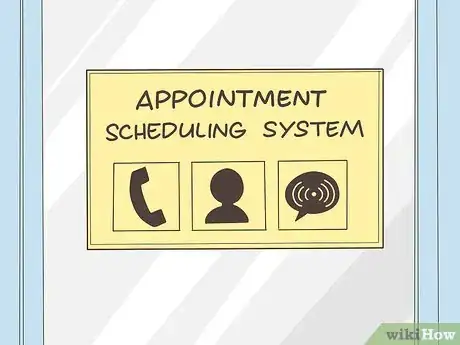
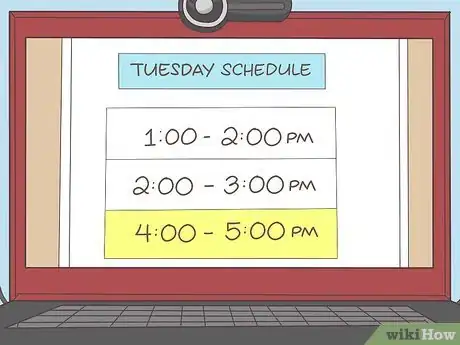
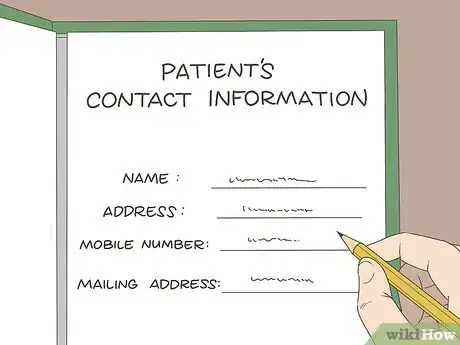
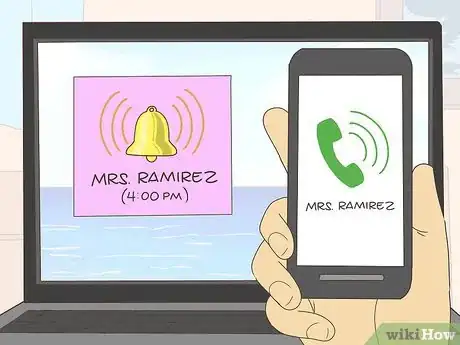





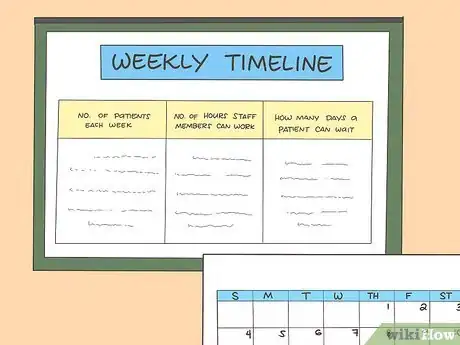


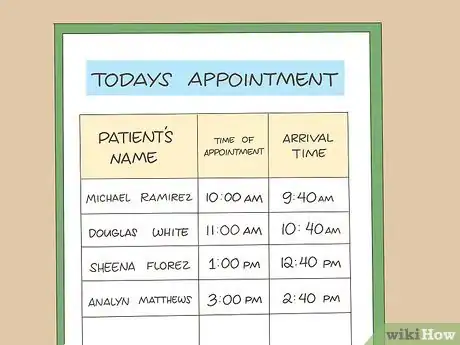




























































Medical Disclaimer
The content of this article is not intended to be a substitute for professional medical advice, examination, diagnosis, or treatment. You should always contact your doctor or other qualified healthcare professional before starting, changing, or stopping any kind of health treatment.
Read More...